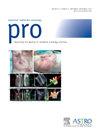Hypofractionated Partial Breast Reirradiation in the Conservative Retreatment of Breast Cancer Local Recurrence
IF 3.4
3区 医学
Q2 ONCOLOGY
引用次数: 0
Abstract
Purpose
To evaluate the outcome of partial breast reirradiation (re-PBI) with intensity modulated radiation therapy using a hypofractionated scheme for breast cancer (BC) local relapse (LR) operated on with repeat breast-conservative surgery.
Methods and Materials
Intensity modulated radiation therapy-based re-PBI was performed using either helical or step-and-shoot modality to deliver 37.05 Gy in 13 fractions in 2.5 weeks. Cumulative incidence of second LR, toxicity, disease-free survival (DFS), BC-specific survival, and overall survival were evaluated.
Results
Between May 2012 and May 2021, 70 patients had re-PBI. The median follow-up (FU) was 6.3 years (quartiles 1-3, 4.0-8.1.). The median age at first LR was 62 years. The median primary BC first LR interval was 12.4 years (range, 1.6-26.7 years). Luminal A-like first LR accounted for 41% of the cases, and the median size was 0.8 cm. During FU, 18 (26%) patients showed a subsequent event: 3 second LRs (corresponding to an 8-year cumulative rate of 4%), 3 regional nodal recurrences, 7 distant metastases, and 5 other primary tumors. At 8 years, DFS, BC-specific survival, and overall survival were 76%, 90%, and 90%, respectively. At multivariate analysis, grade 3 and extensive intraductal components were independent predictors for DFS. For 51 and 46 patients, chronic toxicity and cosmesis were evaluated, respectively: 4% had grade 3 fibrosis, and cosmesis was deemed good/excellent in just >60% of the cases.
Conclusions
Re-PBI after repeat breast-conservative surgery represents a feasible alternative to mastectomy with regard to local control, showing an acceptable toxicity profile. A long-term FU is crucial to better understand the pattern of relapse and consolidate the position of re-PBI in clinical practice.
乳腺癌局部复发保守再治疗中的低分次部分乳房再照射。
目的:评估使用强度调制RT(IMRT)进行乳腺部分再照射(re-PBI)的疗效,采用低分量方案治疗乳腺癌(BC)局部复发(LR)和重复保乳手术(re-BCS):方法:基于IMRT的再保乳手术采用螺旋或阶梯射频模式,在2.5周内分13次照射37.05 Gy。结果:在2012年5月至2021年5月期间,患者共接受了4次IMRT治疗,其中2次为第2次LR的累积发生率(CumI)、毒性、无病生存率(DFS)、BC特异性生存率(BCSS)和总生存率(OS):结果:2012年5月至2021年5月,70名患者接受了再PBI治疗。中位随访时间(FU)为 6.3 年(Q1-Q3,4.0-8.1 年)。第一次LR的中位年龄为62岁。原发性 BC-1 1stLR 的中位间隔为 12.4 年(范围:1.6-26.7)。腔隙 A 型第 1LR 占 41%,中位大小为 0.8 厘米。在治疗期间,18 例(26%)患者出现了后续事件:3 例 2snLR(8 年累计率为 4%)、3 例区域结节复发、7 例远处转移和 5 例其他原发肿瘤。8年后,DFS、BCSS和OS分别为76%、90%和90%。在多变量分析中,3级和广泛导管内成分是预测DFS的独立因素。分别对 51 名和 46 名患者的慢性毒性和外观进行了评估:4%的患者出现了3级纤维化,超过60%的病例被认为外观良好/极佳:结论:就局部控制而言,再行前列腺切除术后再行盆腔转移术是乳房切除术的一种可行替代方案,其毒性也可接受。为了更好地了解复发模式并巩固再行乳房指压术在临床实践中的地位,长期的FU至关重要。
本文章由计算机程序翻译,如有差异,请以英文原文为准。
求助全文
约1分钟内获得全文
求助全文
来源期刊

Practical Radiation Oncology
Medicine-Radiology, Nuclear Medicine and Imaging
CiteScore
5.20
自引率
6.10%
发文量
177
审稿时长
34 days
期刊介绍:
The overarching mission of Practical Radiation Oncology is to improve the quality of radiation oncology practice. PRO''s purpose is to document the state of current practice, providing background for those in training and continuing education for practitioners, through discussion and illustration of new techniques, evaluation of current practices, and publication of case reports. PRO strives to provide its readers content that emphasizes knowledge "with a purpose." The content of PRO includes:
Original articles focusing on patient safety, quality measurement, or quality improvement initiatives
Original articles focusing on imaging, contouring, target delineation, simulation, treatment planning, immobilization, organ motion, and other practical issues
ASTRO guidelines, position papers, and consensus statements
Essays that highlight enriching personal experiences in caring for cancer patients and their families.
 求助内容:
求助内容: 应助结果提醒方式:
应助结果提醒方式:


